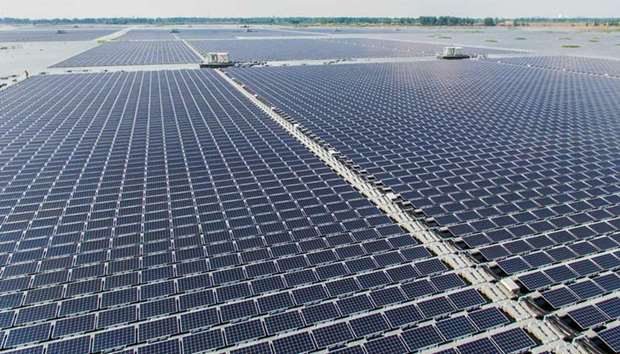An estimated 240 million of the 1.3 billion people in India still live without electricity. The country is now racing to connect thousands of villages with power as it looks to accelerate growth and attempts to emerge out of neighbouring China's shadow.
After a few hours drive from New Delhi, a group of boys playing cricket on a dirt road point the directions to Anandpur, one of the latest Indian villages to be given electricity.
Located near the iconic Taj Mahal, often on the itinerary of world leaders who extol India's economic achievements, Anandpur is mired in poverty. It is home to 275 inhabitants, mostly farmers and daily-wage labourers.
The hamlet's oldest member, 76-year-old farmer Saudan Singh, says he has not seen electricity at his home from the time he was born - well before India's independence from British rule in 1947.
‘My entire life has been spent in darkness. Nobody cared for us. Officials neglect us and politicians disappear after seeking votes during election time,’ says Singh.
Fed up of leading sub-human lives without basic amenities, many families migrated to towns and cities. Anandpur was looked down upon as backward - potential grooms were often shunned by families from nearby villages.
Due to lack of lighting, people felt unsafe and locked themselves in their houses in an undeclared curfew after sundown, says Ram Singh Yadav, a junior army officer, who is visiting his village.
The change came in 2016, when power pylons were installed under a government scheme to link villages to the national grid. By the next year, all households were connected and had the free electricity meter installed.
Irrigated by electric pumps, the once fallow fields have turned fertile with bright yellow flowers of mustard blossoming after a brief winter.
Agricultural productivity in the village, which grows wheat, maize and millets, jumped nearly 10 times, villagers say.
‘Previously, we worried where our next meal would come from. Now we are self-sufficient and our village has seen some progress,’ says Singh, head of an eight-member family.
‘Our children can now study late into the evenings. Electricity brought us out of the dark ages.’ The electrification of 18,452 Indian villages like Anandpur tops the agenda of Prime Minister Narendra Modi's government. Under a scheme launched in 2015, 15,183 villages were electrified by November 2017.
In September, the government unveiled another scheme, 'Saubhagya' (good fortune in Hindi), to acheive ‘last-mile’ electricity connections to all remaining rural and urban households by the end of 2018.
‘In India, 40 million of the 250 million families are still living in darkness. After 70 years of independence, I feel that electricity should reach the houses of those families, I have set a deadline for this,’ Modi said in a rare interview to broadcaster Times Now.
In a change from yesteryears, Anandpur is abuzz in the evenings. Sometimes, over a dozen people gather to watch their favourite films and programmes at Ram Kishore's house - one of the four homes in the village with a TV set.
‘Most villagers have mobiles now, some have TVs. People are finally able to connect with the world outside and get to know more about it. It has opened our doors to the world,’ Yadav says.
As Anandpur opens up to the world, Modi, too, is reaching out to the international community, becoming the first Indian premier to attend the World Economic Forum at Davos in 20 years.
For years, India, the world's biggest democracy with proven scientific prowess that has sent probes to Mars, has been seen to have fallen short of expectations. It was unable to meet its economic potential and struggled to provide its citizens basic amenities and infrastructure.
Modi claims he is tackling the country's policy inertia, large-scale corruption and infrastructure constraints, to help India turn the corner.
At Davos, Modi is expected to pitch India as an attractive investment destination as well as a growth engine for the global economy.
In recent months, the Indian prime minister has faced criticism of his handling of the economy - specifically, for two reforms: demonetization and the hasty implementation of a nationwide goods and services tax.
He also faces the formidable task of creating 12 million jobs annually as well as relieving a protracted agrarian crisis.
Despite these challenges, Modi appears to be succeeding in creating a positive business sentiment. India received over 60 billion dollars in foreign investment in the last financial year, representing an all-time high.
The country also made an unprecedented jump of about 42 places in the World Bank's Ease of Doing Business index over the last three years.
Comparisons are inevitably made to the impressive economic progress by India's neighbouring rival, China. India lost the tag of the world's fastest growing major economy to China in the past year, but is expected to regain it this year, assessments say.
As the last of Indian villages like Anandpur light up to become cogs of the economy, New Delhi is also building one of the fastest growing renewable and solar power programmes in the world.
The country is accelerating efforts to achieve its ambitious target of adding 175 gigawatts in renewable energy by 2022, Power Minister Raj Kumar Singh said.
A focus area at the Davos summit is on green projects.
Officials point out that alongside India's electrification push via coal-powered stations, solar power is being used in remote regions like the mangrove delta of Sundarbans or for street-lighting in towns and cities.
Solar panels are also being made available at highly subsidized rates to popularize their use.

